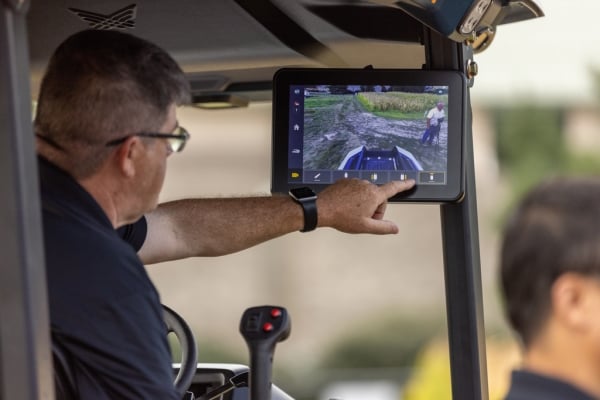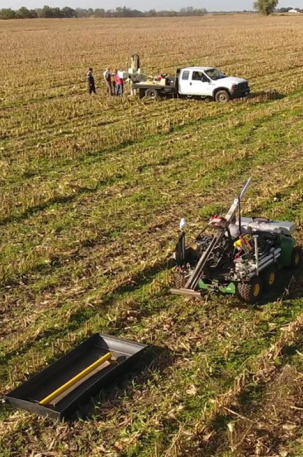You have /5 articles left.
Sign up for a free account or log in.
Washington State University’s AgAID Institute hosted a field day to showcase its orchard technology.
Steve Mantle/innov8.ag
Kent Shannon and a handful of students trudge out to a 55-acre cropland four miles south of the University of Missouri’s main campus. The students bring tools—not tills, tractors or plows, but sensors that use artificial intelligence to measure soil moisture, cameras that distinguish weeds from crops and drones to oversee plant growth from above.
The literal field trip, part of a new program in Mizzou’s College of Agriculture, Food and Natural Resources, is one of the latest instances of university agriculture programs planting a flag at the intersection of farming and technology. Such efforts are on the rise, leveraging everything from AI to robotics to ensure students are prepared for a changing industry.
“A lot of universities are realizing the possibilities that agriculture can provide to train the next generation of workforce in terms of statistics, mathematics, AI, chemical engineering—they all have a very tangible use case,” said Baskar Ganapathysubramanian, the director of Iowa State University’s AI Institute for Resilient Agriculture. “It’s saying, ‘Here is a problem that impacts all of society.’”
A Growing Investment
Technology has always co-existed with agriculture, but, over the last few years, there has been a concerted cross-pollination. In 2020, the National Science Foundation launched its National Artificial Intelligence Research Institutes, intended to boost AI research and workforce development. The effort now spans 25 institutions, with five higher education institutions tapped to focus on boosting the use of AI in agriculture. Each of the five universities received $20 million to spend over five years.
Those included Washington State University, which has a program focused on orchard crops such as cherries, apples and grapes.
“All five of the institutes are motivated with getting undergraduates excited,” said Jordan Jobe, who has managed the AgAID Institute, which seeks to use AI for workforce transformation, since it launched at WSU in 2021.
“It’s frankly the direction agriculture is heading across the U.S.,” she said. “There’s fewer workers and less water and less laborers, so we will need to find ways to address the changing landscape. And AI is part of that.”

The University of Missouri is deploying drones to aid in agriculture work.
University of Missouri College of Agriculture, Food and Natural Resources
A majority of agriculture industry players—87 percent—are using AI, up from 84 percent in 2019, according to a report from RELX, a British information technology group.
Dennis Buckmaster, dean’s fellow for digital agriculture at Purdue University, said there is also an increase in potential research funding from entities like the USDA and NSF.
“There is a little of a push for the projects that involve advanced technologies; that’s where the future is, so that’s where we’re pushing the frontier,” said Buckmaster, who is also a professor of agriculture and biological engineering at Purdue.
Purdue is part of the NSF-backed Internet of Things for Precision Agriculture initiative, which uses data pipelines and sensors to bolster food and water security. The projects include using cameras to monitor the feed intake of dairy cows, which, Buckmaster said, “has huge implications” for sustainability, feed efficiency and animal welfare.
Industry Need—and Hesitancy
Students who learn technology skills in an agricultural setting will have their pick of jobs postgraduation, according to Buckmaster.
“[Student] interest is growing, but it’s not growing fast enough,” he said. “The industry is clamoring for them—if they can find a person who understands code, technology and agriculture, they can write their own ticket.”
Iowa State’s Ganapathysubramanian said he has seen an increase in STEM-focused students wanting to apply their skills to the farming industry, versus working in more traditional technology roles, where “people are getting jaded.”
“This is a refreshing change,” he said. “You’re using it for food and impacting people positively.”
Iowa State is deploying a large language model to identify species: users take an image and the AI says what type of plant or insect it is.
Ensuring farmers are not left behind by technology has been a big part of the robotics work at Washington State University.
“The way these technologies are discussed can feel scary, but the reality is it can help increase yield or use less water and produce better outputs,” WSU’s Jobe said. “There’s a lot of exciting ways technology can be used that’ll have positive impacts, but you have to communicate that clearly going forward.”

The University of Missouri College of Agriculture, Food and Natural Resources is using technology including drones, water-tracking sensors and this autonomous tractor.
University of Missouri
University of Illinois Urbana-Champaign’s Artificial Intelligence for Future Agricultural Resilience, Management, and Sustainability Institute (AIFARMS) is working with technology company Earth Sense to create what is essentially a Roomba for farming. The robot uses AI to navigate fields, ducking between cornstalks to plant cover crop, or crops that protect the soil from wind and erosion in the winter.
The university launched a pilot program to deploy the technology in 5,000-acre increments and “very quickly sold out of farmers” wanting to participate, according to Jessica Wedow, executive director of AIFARMS.
“Farmers seem to be pretty willing to adopt some of these technologies,” Wedow said.
In turn, those farmers hope to recruit students who may have left rural communities, bringing them back into the workforce.
“They can say, ‘Farming is not just what your grandfather, your father did,’” she said. “It can be brought to the forefront of technology and you can study principles like AI using agriculture.”





